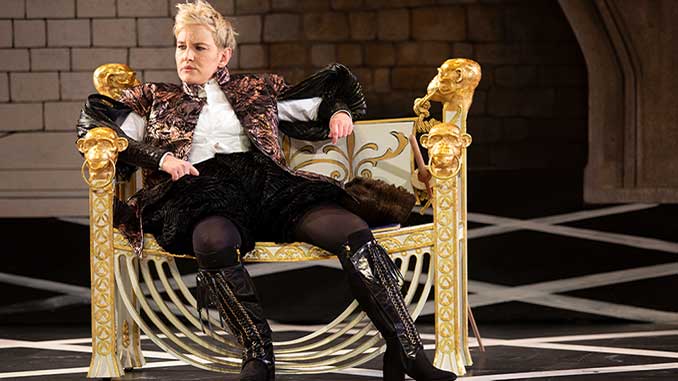 Sarah Bernhardt was a super-famous French actor in the late 19th and early 20th century. Her world fame came from tours, she had her own theatre in Paris, and it’s worth a quick google to learn more about her.
Sarah Bernhardt was a super-famous French actor in the late 19th and early 20th century. Her world fame came from tours, she had her own theatre in Paris, and it’s worth a quick google to learn more about her.
US writer Theresa Rebek’s Bernhardt/Hamlet (2018) is a fictional imagination of 1899 when Bernhardt’s company was rehearsing for Hamlet, with their leading lady playing the titular prince. How dare she!
The script is as much a love letter to Bernhardt as a deconstruction of the Shakespeare canon and an ongoing scream at how women are presented on stages and treated in an industry that thinks it does better than it does.
It feels like an ideal choice for Anne-Louise Sarks’ directorial debut as the new Artist Director of the MTC, a company that is addressing questions and criticisms of presenting canon and focussing on issues of inequality and representation on our stages.
Kate Mulvany as Bernhardt makes the choice of work even more relevant to mainstage Australian theatre. Mulvany actively works for equity and representation on and off our stages, and in 2018 she dramaturged and played the Dick in Richard III for Bell Shakespeare.
I’ve seen a few Richards – including Antony Sher and William Zappa – and Mulvany brought women into the work in a way that I had never seen before. It was nice to see women as more than wives, potential shags or jokes in a revered canon work. And her performance was driven by power and physical pain; it wasn’t about gender.
If she can make us care about a character written to be hated, what could she do with that young Danish prince?
In Bernhardt/Hamlet, Bernhardt questions everything about Hamlet and why a moody teenager – no he’s not 30; it’s an ongoing joke – is given such reverence and why Shakespeare’s “da da-da da-da” poetry is so revered. Why not re-write it? She also had a famous writer willing to do anything for her.
As Bernhardt questions everything – and is told what to think by her male entourage of actors, writers, artists, critics and own teenage son – Sarks layers on more questions.
Questions about the reverence we give to fame, being in the literal limelight, being written about by critics, getting the right look on a poster, aging, physical appearance, having a private life, having power in an industry where Bernhardt had to create her own power, the cringe of describing woman as having power…
They are all very serious theatre discussions that we have to keep having, but there is so much joy in this work and it leads us into the discussions with humour.
It’s all a bit silly and often gloriously silly. From Hamlet’s puffy-leg britches and ridiculous page-boy-bob wig to Bernhardt trying to walk up a backdrop staircase, Sarks’ direction begins by laughing at ourselves and our righteous seriousness about theatre.
The tone is defined, continued and changed by Marg Horwell’s set and costumes, lit by Amelia Lever-Davidson. Lavish, outrageous and historically hilarious (there are so many references to the real history tied up with an extra shiny bow and giant flower about now), her design reflects what might have been imagined in Bernhardt’s head but more what we’d like to imagine it was like to be in that theatre and time.
Years ago, when Horwell worked on small shows with no budget, she found the writer’s intent in a work, clarified and magnified it in ways that let audiences know everything we needed to know at a glance. When she works with a generous budget (she also designed The Picture of Dorian Gray), this magnification is intensified with subtle and not-at-all subtle layers of meaning and understanding.
With a consistently excellent cast that reflects our industry, Sarks’ direction ensures that each character adds to the ongoing struggle of Bernhardt’s power and position. After all, there is still coverage and discussions that refer to Sarks being a woman, rather than an established, experienced and creative director…
All of which leave Mulvany’s complex and magnificent Bernhardt in the centre. Her performance captures the bravado Bernhardt needed to succeed, the ego of wanting to live up to her reputation, her genuine love and understanding of theatre, and her hurt of being rejected or seen as nothing more than a woman to gaze at.
Bernhardt/Hamlet is so much more than a discussion about gender and representation in theatre, but 120-odd years later it feels too familiar. My initial reaction was that, surely, we can move on from these discussions, but if we were ready to move on, this play wouldn’t have been written and it wouldn’t have been chosen to be on this stage.
Bernhardt/Hamlet
The Sumner – Southbank Theatre, Southbank Boulevard, Southbank
Performance: Saturday 11 March 2023
Season continues to 15 April 2023
Information and Bookings: www.mtc.com.au
Image: Kate Mulvany in Bernhardt/Hamlet – photo by Pia Johnson
Review: Anne-Marie Peard
